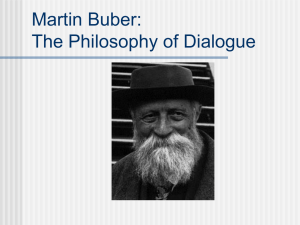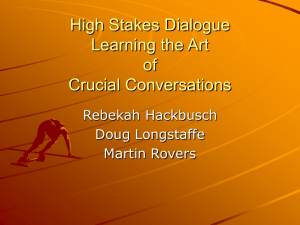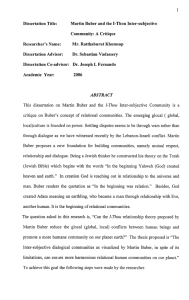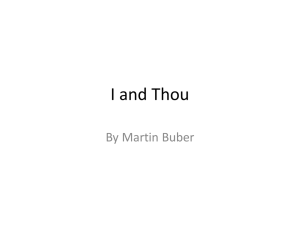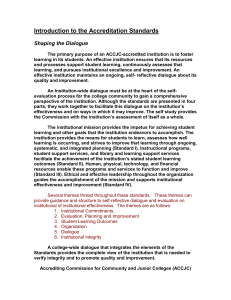Dialogue - Ashridge
advertisement
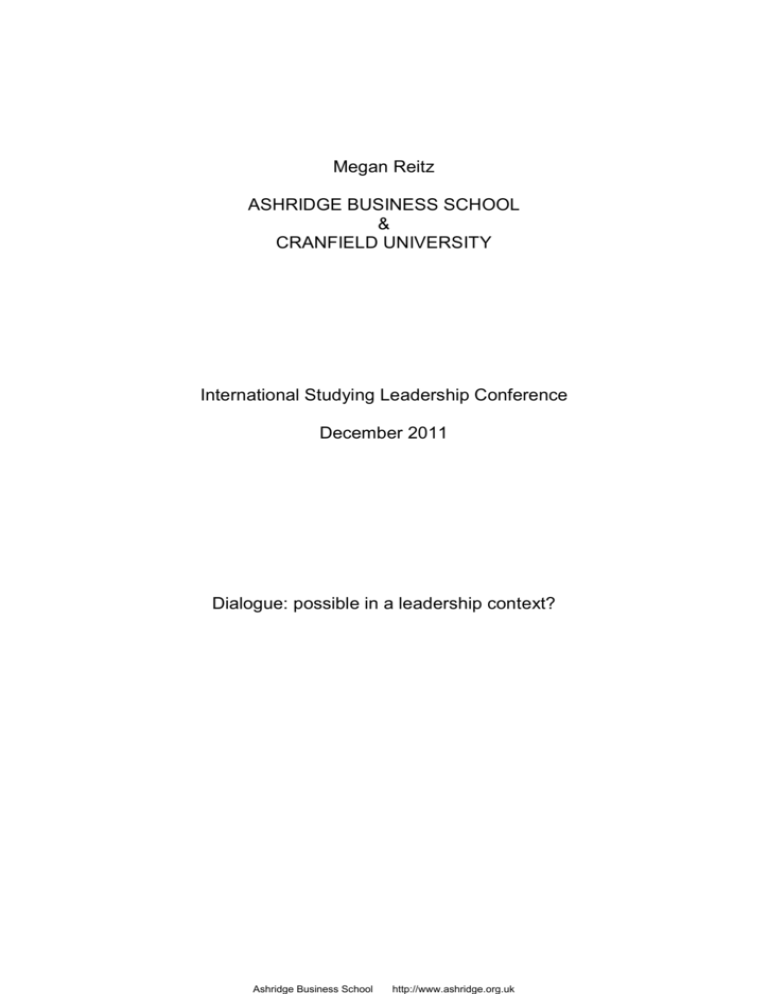
Megan Reitz ASHRIDGE BUSINESS SCHOOL & CRANFIELD UNIVERSITY International Studying Leadership Conference December 2011 Dialogue: possible in a leadership context? Ashridge Business School http://www.ashridge.org.uk Ashridge Business School http://www.ashridge.org.uk ABSTRACT Confronted with the complexity of the world today leaders are being urged more than ever to build open, authentic relations with their ‘followers’ in order to be able to ethically tackle the issues we face. Specifically, dialogue has been recommended as a relational approach which encourages high quality contact. Extant literature on dialogic leadership however is sparse so this paper aims to explain some of the factors which might encourage or inhibit leader-follower dialogue using the ideas of Martin Buber as an inspiration. I suggest that despite the traditional power and status differences between a positional leader and their followers, it may be possible to encourage moments of dialogue by for example holding true respect for the worthiness and uniqueness of the other’s views, suspending judgement, being authentic and fully present to the other and being open to change and learning. 3 Ashridge Business School http://www.ashridge.org.uk “There is no escaping the demands of leadership...life moves faster and faster” according to McKee and Massimilian (2006:45) who go on to suggest that leaders “juggle multiple requests, realizing somewhere in the back of [their] minds that [their] focus is becoming increasingly short-term…[with] less and less time for reflection”. It would seem that this is the normal environment in which leaders make decisions. And yet the advantages of taking more time to be mindful of one’s connection to others and seeking to improve the quality of relating and conversing are being increasingly considered in order to reap the benefits of improved ethical decision making (Simpson et al., 2002), as well as aiding creativity (McNamee and Shotter, 2004), improving organisational learning (Mazutis and Slawinski, 2008), and increasing organisational knowledge (Tsoukas, 2009). Specifically, dialogue has been increasingly cited as a relational approach to leadership (see Uhl-Bien, 2006) that has been “used in increasingly widespread repute” (Isaacs, 2001:710) and can, through building high quality contact between leaders and followers that is open, creative and meaningful, lead to ethical organisational learning and change, (see for example Deetz and Simpson, 2004; Fletcher and Kaufer, 2003; Heath, 2007; Heath et al., 2006; Mazutis and Slawinski, 2008; Senge, 2006). However, as dialogue has been described as a murky and contested concept (Anderson and Cissna, 2008; Deetz and Simpson, 2004), with a corresponding spectrum of interpretations, the path to forming dialogic relationships is unclear and bewildering for leaders. Martin Buber, “one of the great twentieth century philosophers” (Stern, 2009:273), is one of the most well-known authors in the field of dialogue and his “influence on modern thinking about dialogue overshadows almost all others” according to Isaacs (2001:713). He developed an interpretation of dialogue which he referred to as I-Thou relations, characterised by genuinely meeting the other in the present and contrasted this to I-It relations, the more common way in which we encounter others; as objects and as a means to our own ends. 4 Ashridge Business School http://www.ashridge.org.uk Buber’s ontological perspective, his views on the nature of relating and his guidelines on how to evoke a particular quality of encounter have been applied extensively to the education and therapeutic fields. As application of Buber’s ideas is clearly also deemed appropriate and of interest to the leadership field, (see Anderson, 2010; Ashman and Lawler, 2008; Bradbury and Lichtenstein, 2000; Deetz, 2010; Friedman, 2010; Isaacs, 2001; Lawler, 2010), this paper seeks to uncover how authors writing in the leadership domain have applied his ideas to date and how the work of authors in the educational and therapeutic fields can provide further guidance specifically to those factors which may encourage or inhibit dialogic relations between leader and follower. This paper begins by positioning the field of inquiry describing the main literature domains of leadership and dialogue, with a focus on relational leadership and Buber’s I-Thou dialogue respectively. Factors which may encourage or inhibit dialogue are then collated from the literature which focuses generically on I-Thou dialogue; the literature that brings leadership and dialogue together explicitly; and finally the literature that applies I-Thou dialogue to the analogous education and therapy fields. The reasons why further research bringing relational leadership and Buber’s work together should be encouraged is then made. With regards to the first domain, there is an extraordinary preponderance of literature relating to leadership. The subject seems to know no boundaries in terms of the level of interest aimed at it. It often seems to be singularly regarded as the cause of high performance and the reason for organisational downfall. Books asserting how to be a leader in 5, 6, 7 or more steps appear every year and yet there is absolutely no agreement on what a leader, or leadership actually means. A development which has occurred primarily in the last twenty years is the growing field of relational leadership and connected to this the increasing debate around the social construction of the phenomenon of leadership. UhlBien (2006:654) paves the way for clarification of this area in her Leadership 5 Ashridge Business School http://www.ashridge.org.uk Quarterly article which outlines two main perspectives: an entity approach “that focuses on identifying attributes of individuals as they engage in interpersonal relationships”, and a relational perspective “that views leadership as a process of social construction through which certain understandings of leadership come about and are given privileged ontology”. Relational Leadership Theory (RLT) is then offered by Uhl-Bien as “an overarching framework for the study of leadership as a social influence process through which emergent coordination….and change…are constructed and produced”. As the foremost philosopher in relational dialogue, Martin Buber may have a significant contribution to make to this youthful leadership field both theoretically and pragmatically and it is to his work situated in the broader dialogue literature I now turn. The array of definitions given in relation to the word ‘dialogue’ can be quite overwhelming. It apparently means “a joint activity between at least two speech partners in which a turn taking sequence of verbal messages is exchanged between them, aiming to fulfil a collective goal” (Tsoukas, 2009:943), and yet it awakens the hope of reaching a situation “where people might soften or drop the barriers between them, perhaps even transcend them and so find nonobjectified, genuine meeting” (Isaacs, 2001:713). Amidst all of this Deetz and Simpson (2004) warn that as “dialogue foregrounds specific normative hopes” (p141), “the coupling of high expectations with an ill-defined and murky concept increases likelihood of disappointment” (p152). To make sense of this ‘murky concept’ it helps to understand the historical lineage of the term which illuminates some of the key elements of definitional difference that exist between authors. Figure 1 below illustrates five philosophers fundamental to the dialogue literature who are “among the most frequently referenced philosophers of communication whose works foreground the term dialogue” (Stewart et al., 2004:22) and summarises the different perspective each brought to the field. Buber was the first to coin the term dialogue specifically and his influence can be explicitly determined in the writing 6 Ashridge Business School http://www.ashridge.org.uk of Gadamer (1989), Bakhtin (1981) and Freire (1990), (Gadamer refers frequently to I and Thou although he makes no acknowledgement of Buber, whilst Bakhtin, and Freire openly recognise Buber’s influence on their own work. Bohm (1996) drew predominantly on very different sources of inspiration such as Einstein given his background in physics). More recent prominent authors are also mentioned in Figure 1 (see Anderson et al. 2004; Stewart et al., 2004) connected to the authors who appear to have influenced them most. The diagram is highly simplistic in this area since the network of influences is complex with one author influenced by a plethora of others past and present. Nevertheless the diagram illustrates how wide the field is and how the current writing is influenced still very significantly by the ‘original’ authors last century and in particular Buber whose “appropriation of [the term dialogue] has been most influential” (Stewart et al., 2004:32). Figure 1: the historical development of 'dialogue' literature 7 Ashridge Business School http://www.ashridge.org.uk Buber can be described as a philosophical anthropologist (Anderson et al., 2004; Arnett, 2004). His book I and Thou, (1958) is his best known work with Friedman (writing in the forward of Kramer, 2003:ix) claiming that he “can think of no work of more lasting importance for our times”. It is clear from Figure 1 above that he has been extremely influential and is perhaps “the most widely known 20th-century philosopher of dialogue”, (Stewart et al., 2004:24). Buber’s particular interest area is in the nature of our relationships with others in the world around us, (including inanimate objects, animals and God as well as other human beings). This relationship can be either ‘I-Thou’ in nature or ‘I-It’. Buber says: “To man the world is twofold, in accordance with his twofold attitude. The attitude of man is twofold, in accordance with the twofold nature of the primary words which he speaks. The primary words are not isolated words, but combined words. The one primary word is the combination I-Thou. The other primary word is the combination I-It …..the I of the primary word I-Thou is a different I from that of the primary word I-It”, (Buber, 1958:15) One can see from these words why Buber is acclaimed for his poetic language, but at the same time sometimes criticised for being vague with his concepts (see Isaacs, 2001). The critical elements to draw out here are that ‘I-Thou’ relations can be identified in terms of the quality of intersubjective partnership present. In contrast, in ‘I-It’ relations, the other is viewed as a separate object, perhaps as something which can be used to serve our own purposes, and thus has the nature of one-sidedness. The former can be described as true meeting, whereas the latter implies mismeeting. Fundamentally Buber argues that indeed “all real living is meeting” (1958:25), in other words we are always relating; it is the nature of being human to be in relationship, and it is when one glimpses the very nature and depth of this relationship that one encounters the ‘I-Thou’. 8 Ashridge Business School http://www.ashridge.org.uk Buber’s ontology focused on knowledge forming only in relation to the otherness encountered in the world. Thus he offered a very different ontology to that which was popular at the time that he was writing, i.e. the Cartesian view of the world which focused attention on individuals as the source of knowledge and meaning. Buber did not mention the word ‘dialogue’ in I and Thou, however in later works (Buber, 2002) he identified three realms of dialogue: genuine dialogue when the participants meet each other as ‘Thou’; technical dialogue when there is simply a need for objective understanding between participants; and monological events where a participant speaks “with himself in strangely tortuous and circuitous ways and yet imagine[s] they have escaped the torment of being thrown back on their own resources” (Buber, 2002:19). All these forms of dialogue are appropriate at times however Buber claimed that fundamentally one is not fully human unless one experiences others, the world around them and God as ‘Thou’ in genuine dialogue and unfortunately, “the exalted melancholy of our fate [is] that every Thou in our world must become an It” (Buber, 1958:31). Buber’s writing is evocative and poetic, but as a result might not be at all accessible to a pragmatic individual who seeks any clear ‘how to’ advice. The question guiding this systematic review is what does the literature suggest are the factors which encourage and inhibit leaders from entering into ‘I-Thou’ dialogue with their followers? In order to thoroughly address this question it became apparent that it was necessary to review the following in detail: • The nature of I-Thou dialogue and the general enablers and inhibitors to it • The literature relating to I-Thou dialogue and leadership and the specific enablers and inhibitors to it in this context • The literature relating to I-Thou dialogue and the analogous teacherstudent and therapist-client relationships which are also defined by status 9 Ashridge Business School http://www.ashridge.org.uk and power differences with each party to the relationship having differing aims (see Anderson, 2010; Ashman and Lawler, 2008; Friedman, 2010; Lawler, 2010). Looking firstly at the general literature on I and Thou, it became clear that Buber argued that of the two-fold ways of being in relationship, the I-It is the norm with I-Thou existing rather in moments which “cannot be lionized….cannot become business as usual and…cannot be planned precisely or made to happen” (Anderson et al., 2004:15). And as I-Thou encounter occurs between people, it is “a two sided event that is not susceptible to techniques in the sense of willing and manipulating to bring about a certain result” (Friedman, 2009:412). These characteristics clearly hold fundamental implications in relation to the research question; the authors with an understanding of Buber’s ontology do not write about what ‘enables’ or ‘inhibits’ I-Thou dialogue. To do so would be to separate dialogue out as a ‘thing’ to be obtained or avoided. “One reason most prescriptive writers [like those writing about Buber’s ideas and Buber himself] avoid presenting a list of steps or techniques is that, whatever their differences in emphases, they view dialogue as a situated relational accomplishment…because it is praxis…there are many ways to ‘do’ dialogue, and one cannot predict in advance exactly what it will take for this quality of contact to come into being” (Stewart and Zediker, 2000:230). Rather these authors follow Buber’s lead in offering suggestions relating to orientations or approaches which might be conducive to cultivating I-Thou encounter. These include mutuality and inclusion, confirming others, being rather than seeming and unfolding rather than imposing. Mutuality requires an openness to change, to learning, to really understanding an other’s perspective. Inclusion of the other is not the same as empathy which implies one abandons one’s own thoughts and feelings in preference for the other’s. Rather it is fully seeing and experiencing the other whilst retaining one’s own position. “Imagining what you are perceiving, thinking, feeling and willing is how I include you in genuine dialogue. I can be empathetic or intuitive in our 10 Ashridge Business School http://www.ashridge.org.uk relationship, but unless I swing boldly and wholeheartedly in your direction I will not make you fully present to myself” (Friedman 2009:415). Inclusion means being the subject of someone’s undivided attention. The first orientation therefore is a general belief that the other is unique, of importance and very much worth listening to. Confirmation requires one to hold from the normal ways of categorising and judging others; “elemental relation is possible when all means by which the meeting with the Other might be categorised, directed, and controlled are left behind” (Pinchevski, 2003:154). This second orientation means that if you confirm another, you are completely holding the view that the other is worthy of taking the time to be with in the present, which is perhaps an important point to consider in relation to the ‘busyness’ of organisational leaders (see Simpson et al., 2002). A person must let down the barriers which they construct to the outside world and let the other see them as themselves rather than the mask which is usually portrayed. “When a person seems, he or she is concerned with a certain image and works to create that image to further personal goals….Being entails an authentic relationship focused on the interaction as it happens. Any person in dialogue therefore must have suspended judgements of the other and be fully authentic”, (Howard, 2002:1131), which is the third orientation. Finally, “an imposer is not concerned with the other unless the other is to be exploited or defeated, whereas an unfolder is one who understands and enriches the life of the other” (Howard, 2002:1132). To impose means to relate to an other for the sake of our own ends rather than for the sake of what potentially could be created together. This fourth orientation therefore advocates a seeking out of the Other not in order to get what you want done done, but rather in the knowledge that what can be created between is potentially fulfilling. 11 Ashridge Business School http://www.ashridge.org.uk Having discussed the general orientations conducive to dialogue, I now go on to look at the specific factors explored in the leadership literature. Ashman and Lawler (2008) is the only peer reviewed article that directly addresses how Buber’s work might apply to the leader-follower context, posing the question “whether it is possible for [I-Thou] dialogue to occur between leader and follower” (p263). A number of other papers, although focused on different purposes, make at least some mention of the implications of Buber’s work on leadership; (see for example Caldwell and Dixon 2010, Fletcher and Kaufer 2003, Hammond et al. 2003, Lichtenstein et al. 2006 and Slotte 2006), however it is clear that the extant literature bringing I-Thou dialogue and leadership together is sparse. From exploring the papers which do link the two subjects I have summarised the implications which are of relevance to the question of this review, into three areas shown in Figure 2 for clarity. The first two sets of issues relating to the perception of, and the communication between leader and follower represent hindrances to I-Thou encounters. In contrast the third set of ideas relating to the possibilities opened by different definitions of leadership indicate how I-Thou might be encountered in the leader-follower relationship. These points are elaborated further below. Figure 2: Buber's ideas related to leadership 12 Ashridge Business School http://www.ashridge.org.uk In relation to the first area, traditionally, leader and follower are seen to possess differing status and along with that power. Leadership is therefore often regarded as a synonym for positional hierarchical authority, (see Ashman and Lawler, 2008; Hammond et al., 2003). This in turn leads to followers, at least implicitly, being regarded as passive and needing a leader in order to motivate or empower them to do something. Additionally the leader is often expected to live up to heroic expectations and any possibility of the leader exhibiting vulnerability or humility is disregarded (Ashman and Lawler 2008). Coupled with this the level of trust in business leaders by followers is relatively low (Caldwell and Dixon 2010) and given Buber wrote about the importance of authenticity this can be regarded as a challenge to leaders and followers wishing to encounter each other in dialogue. 13 Ashridge Business School http://www.ashridge.org.uk So according to these authors the stage is set for a very imbalanced relationship between leader and follower which has further significant implications for the way in which they are traditionally perceived to interact and communicate, as the second area in Figure 2 illustrates. Communication is assumed to be essentially one-directional and Slotte (2006:797) refers to this as the ‘conduit metaphor’ which portrays communication as a pipeline flowing in one direction. In Buberian terms, it is also characterised as primarily technical dialogue; i.e. the communication has a specific purpose to transmit information rather than any overriding purpose to build relationship. In this form of communication followers risk being commoditised or objectified and regarded as a unified homogenous group of people. Any potential that communication might have beyond these purposes is stifled. Even when ‘open communication’ and ‘dialogue’ are espoused by the leader, the reality is that the forums provided for these ‘open’ discussions are designed by the leader, with the leader’s agenda in mind, (Hammond et al., 2003). The one-sided nature of the communication is thus still present. Fletcher and Kaufer (2003:36) additionally warn that leaders rarely get to hear what people really think; “talking nice….[is] a mode of conversation common in organisations. No one shares with the CEO what is discussed in the hallways”. The scene has been set therefore by these authors of numerous obstacles in the leader-follower relationship as it is traditionally perceived. However the literature does see cause for hope in relation to developing dialogical relations as shown in the third section of Figure 2. Whereas previously the traditional view of leadership left little scope for leaderfollower dialogue, recent changes in theory open up more possibilities. A relational perspective as Lichtenstein et al. (2006) in particular describes implies an openness to Buber’s thoughts which has not existed previously. Leadership can and is being reconsidered as a process by which both leader and follower learn. Taken even further Ashman and Lawler argue that dialogue allows the possibility that the fixed nature of roles which is implied in much of the 14 Ashridge Business School http://www.ashridge.org.uk leadership literature could be replaced with a more fluid understanding of ‘leader’ and ‘follower’. The ‘Other’ in terms of the follower is now being focused on increasingly with the elevated role of the leader diminishing. Finally, dialogue as Buber has conceptualised it necessitates openness to change, and embracing of uncertainty and a consequent loosening of agendas as well as ‘leader’ and ‘follower’ roles. Relatively recently leadership theory has begun to accept such possibilities (for example Bathurst and Ladkin, in preparation), although there might be still further to go to persuade leaders themselves; “to engage in a dialogue with no agenda can easily grow into a feeling that it is a waste of time especially if it is a conflict situation and in times of pressing problems” (Slotte, 2006:799). The papers mentioned above, although offering some reasons why I-Thou dialogue is problematic as well as increasingly possible, do not go into the specific detail of how dialogue comes about, or could come about, between leader and follower. In fact I can see no peer reviewed article that does so. Literature linking Buberian dialogue and leadership is scant and overwhelmingly conceptual rather than empirical. In my quest to further understand what might aid or get in the way of leaders and followers relating dialogically, I turn therefore, as Ashman and Lawler (2008) do, to the analogous fields of education and therapy. In relation to education “the major role of Buberian teachers is to establish an encounter with their students; this encounter is the teaching goal itself” claims Shim (2008:532). The question is, can two people with significantly different power and status differences possessing differing objectives, encounter each other in mutuality as I-Thou? According to Black (2005:33) “Buber advocates dialogic education, but acknowledges that the fundamental difference in social roles between teacher and students makes mutuality difficult or impossible”. Particularly important differences are the expertise held by the teacher, the formal assessment of the students by the teacher, the traditional role 15 Ashridge Business School http://www.ashridge.org.uk expectations of both teacher and student by one another and indeed the wider community and the common lecture hall context of teacher-student relating. It would seem to me that some, perhaps all of the factors above may be relevant in leader-follower relations; for example, leaders assess followers through promotions and performance management and leaders can be challenged with encountering followers as unique in the context of an organisation with several thousand staff. The therapeutic articles identified through the systematic review which relate to mutuality and implications for I-Thou dialogue between therapist and client focus on one event in building any claims. That event is the 1957 conversation between Carl Rogers and Martin Buber, “two of [last] century’s leading proponents of dialogue” (Cissna and Anderson, 1994:11-12), Essentially in the conversation Buber and Rogers were debating whether, given the inherent inequality of the relationship between therapist and client, mutuality and therefore I-Thou dialogue was feasible. In Buber’s words, “the essential difference between your [Roger’s] role in this situation and [the client’s] is obvious...he comes for help to you…you see him…he cannot, by far, cannot see you” (Anderson and Cissna, 1997:34). Buber here is suggesting that the relationship is inherently unequal with the client having a very different purpose than the therapist; a purpose which does not include within it a desire for inclusion, i.e. for ‘imagining the real’ of the therapist; rather the client is clearly invested in his or her own learning (see Friedman, 1985, 1998). Rogers believes on the other hand that he has indeed experienced moments of I-Thou dialogue with patients and that “equality is achieved in moments of mutual recognition of basic personness, even if the parties have dissimilar role limitations” (Anderson and Cissna, 1997:38, see also Black, 2008). This mutuality is possible according to Rogers because firstly the therapist can be changed by dialogue with the client (even though it could be presumed that most change might occur with the client). Equality here depends on “the two parties’ granting each other’s perceptions equal authority…Rogers believed that 16 Ashridge Business School http://www.ashridge.org.uk people aren’t helped by experts telling them answers to their problems, but by therapists and clients building a relation of mutual listening on equal experiential footing, even if not on fully equal role footing” (Anderson and Cissna, 1997:41). These factors proposed by Rogers seem to open up the possibilities of I-Thou relational moments in a relationship which is normally characterised by inequality in terms of status, power and purpose. Hazen (1994:397-398) claims that “while the distribution of power in a relationship might be objectively perceived as unequal, those in the relationship can (but not always) transcend roles to meet one another as persons in dialogue, each having something to teach and something to learn from the other, each giving and each receiving”. The steer this literature might give to the leader-follower relationship is one of optimism for dialogic encounters therefore. Figure 3 offers a summary of those factors drawn from the literature which may then encourage or inhibit dialogic relations between leaders and followers. 17 Ashridge Business School http://www.ashridge.org.uk Figure 4: Summary of conceptual findings 18 Ashridge Business School http://www.ashridge.org.uk An examination of the literature therefore can provide leaders with a somewhat clearer view of dialogue and what might be required to create conditions conducive in their organisations for such encounters. Undoubtedly though direct application of Buber’s ideas to leadership has been scant to date and I would argue that now may be an appropriate moment to encourage further research in this area. I believe there is a pressing call for exploration of the possibilities of dialogue in organisations and a practitioner appetite to do so due to: • The constant continuing search for improved performance in organisations and the claims that dialogue can assist in improving ethical decision making (Simpson et al., 2002), creativity (McNamee and Shotter, 2004), learning (Mazutis and Slawinski, 2008), and organisational knowledge (Tsoukas, 2009). • The implications that the prevailing “leadership myth” is having in terms of “its consequences for alienation characterised by intellectual and emotional deskilling” (Gemmill and Oakley, 1992:113), which are being increasingly recognised. The assumption relating to the superiority of leadership is being examined more critically (e.g. Shamir et al., 2007); Buber’s work complements this. • A yearning for more fulfilled organisational experiences that may encourage writers to consider Buber. For instance Sendjaya et al (2008:408) write “lives in today’s modern workplace are often characterised by disconnectedness, compartmentalisation and disorientation” and to counter this, according to Taylor (2008:1), consideration of “the connections between people” is fundamental. • The complexity that organisations face now imply that “in a knowledge-, service-, and wisdom-based economy that is increasingly dependent upon employee commitment, ownership, and responsiveness, organisations need leaders who treat employees as valued partners, ends and “Yous””, as Caldwell and Dixon state (2010:98), directly referencing Buber’s work. 19 Ashridge Business School http://www.ashridge.org.uk • The influence that the changing nature of society may have on organisations’ ability and requirement to tackle difficult issues more appropriately; “the problem of dialogue is likely to become one of the central questions for 21st century communication studies…[because] we live in an increasingly and necessarily pluralised society in an era of persistent conflicts and disagreements across ethnicity, religion, gender, and sexual preference, as well as ideological, economic, power and status distinctions” (Cissna and Anderson, 2004:202). • The way that some high profile organisations have begun to practice dialogue and are speaking out about it; “the top leaders at Shell Oil in the United States have spent the past several years developing their capacity for dialogue. They see conversation as increasingly more critical as their leadership roles shift dramatically” explains Isaacs (1999:22) who cites Buber’s work. CEO of Shell, Phil Carroll, according to Isaacs claimed that “dialogue was at the heart of our work as leaders” (1999:22). Additionally the more recent recognition that leadership could be understood as socially constructed opens opportunities; “in a social world of local realities there is always the possibility socially to construct partnership rather than dominance” (Dachler and Hosking, 1995:23). Furthermore, “dispersed leadership theories, in some cases maybe unwittingly, imply that leadership is not necessarily something that an extraordinary individual does. Rather it is something that many people can do…such a view suggests that the boundaries which once differentiated ‘the leader’ from ‘the follower’ are now very grey” (Gordon, 2002:156). Consequently the debate is already occurring around the very essence of leadership and may therefore be ready to consider the very fundamental implications that Buber’s ideas might have. This paper provides a more thorough examination of the orientations required for dialogic relationships in a leadership context than is currently available in the extant literature. It is hoped this will offer increased clarity to both researchers 20 Ashridge Business School http://www.ashridge.org.uk and practitioners interested in the field. The review demonstrates the value in applying Buber’s ideas on I-Thou dialogue to the leadership field. It is proposed that moments of I-Thou dialogue may be feasible between leader and follower. This paper does not advocate that leaders should be seeking I-Thou dialogue in all that they do with followers. Rather that these moments are important; both parties glimpse what it is to relate in a dialogic manner, and this understanding then imbues their ongoing day-to-day ‘I-It’ interactions with a depth, an ethical insight and closeness which is otherwise unknowable. However a fundamental change in perspective is required to fully appreciate the essence of Buber’s ontology and its implications on leaders. Such a change in perspective necessitates first and foremost a reappraisal of the meaning of leadership itself. This study explains why the time may now be apt for such reappraisal given recent developments in the areas of relational leadership theory. A suggested next step for research in this area would be empirically to examine the way in which leaders and followers experience their encounters. As Ashman and Lawler (2008:264) recommend “just one occurrence of the sort of leader/follower acceptance Buber describes will enlighten us as to the possibilities of genuine dialogue between leader and follower”. 21 Ashridge Business School http://www.ashridge.org.uk REFERENCES Anderson, R. (2010), personal communication. Anderson, R., Baxter, L. and Cissna, K. N. (2004), "Texts and contexts of dialogue", in Anderson, R., Baxter, L. and Cissna, K. N. (eds.) Dialogue: Theorizing difference in communication studies, Sage, London, pp. 1-18. Anderson, R. and Cissna, K. N. (1997), The Martin Buber - Carl Rogers dialogue: A new transcript with commentary, State University of New York Press, Albany. Arnett, R. (2004), "A dialogic ethic "between" Buber and Levinas: A responsive ethical "I"", in Anderson, R., Baxter, L. and Cissna, K. N. (eds.) Dialogue: Theorizing difference in communication studies, Sage, London, pp. 75-90. Ashman, I. and Lawler, J. (2008), "Existential communication and leadership", Leadership, vol. 4, no. 3, pp. 253-269. Bakhtin, M. (1981), The dialogic imagination: Four essays by M.M. Bakhtin, University of Texas Press, Austin. Black, L. (2005), "Dialogue in the lecture hall: Teacher-student communication and students' perceptions of their learning", Qualitative Research Reports in Communication, vol. 6, no. 1, pp. 31-40. Black, L. W. (2008), "Deliberation, storytelling, and dialogic moments", Communication Theory, vol. 18, no. 1, pp. 93-116. Blenkinsop, S. (2005), "Martin Buber: Educating for relationship", Ethics, Place & Environment, vol. 8, no. 3, pp. 285-307. Bohm, D. (1996), On dialogue, Routledge, London. Bradbury, H. and Lichtenstein, B. M. B. (2000), "Relationality in organizational research: Exploring the space between", Organization Science, vol. 11, no. 5, pp. 551-564. Buber, M. (1958), I and Thou, 2nd ed, T&T Clark, London. Buber, M. (1967), “Replies to my critics”, in Schilpp, P. A. and Friedman M. (eds.) The philosophy of Martin Buber, Open Court, LaSalle, IL: pp. 689744. Buber, M. (2002), Between man and man, 2nd ed, Routledge, London. 22 Ashridge Business School http://www.ashridge.org.uk Caldwell, C. and Dixon, R. (2010), "Love, forgiveness, and trust: Critical values of the modern leader", Journal of Business Ethics, vol. 93, no. 1, pp. 91101. Cissna, K. N. and Anderson, R. (1994), "The 1957 Martin Buber - Carl Rogers dialogue, as dialogue", Journal of Humanistic Psychology, vol. 34, no. 1, pp. 11-45. Cissna, K. N. and Anderson, R. (2004), "Public dialogue and intellectual history: Hearing multiple voices", in Anderson, R., Baxter, L. and Cissna, K. N. (eds.) Dialogue: Theorizing difference in communication studies, Sage, London, pp. 193-208. Dachler, H. P. and Hosking, D. M. (1995), "The primacy of relations in socially constructing organizational realities", in Hosking, D. M., Dachler, H. P. and Gergen, K. J. (eds.) Management and organization: Relational alternatives to individualism, Avebury, Aldershot, pp. 1-29. Deetz, S. (2010), personal communication. Deetz, S. and Simpson, J. (2004), "Critical organizational dialogue", in Anderson, R., Baxter, L. and Cissna, K. N. (eds.) Dialogue: Theorizing difference in communication studies, Sage, London, pp. 141-158. Fletcher, J. and Kaufer, K. (2003), "Shared leadership", in Pearce, C. and Conger, J. (eds.) Shared leadership: Reframing the how's and why's of leadership, Sage, London, pp. 21-47. Freire, P. (1990), Pedagogy of the oppressed, Rowman and Littlefield, New York. Friedman, M. (1985), "Healing through meeting and the problematic of mutuality", Journal of Humanistic Psychology, vol. 25, no. 1, pp. 7-40. Friedman, M. (1998), "Buber's philosophy as the basis for dialogical psychotherapy and contextual therapy", Journal of Humanistic Psychology, vol. 38, no. 1, pp. 25-40. Friedman, M. (2008), "Buber and dialogical therapy: Healing through meeting", The Humanistic Psychologist, vol. 36, no. 3, pp. 298-315. Friedman, M. (2009), "The outreach of dialogue", Journal of Humanistic Psychology, vol. 49, no. 4, pp. 409-418. Friedman, M. (2010), personal communication. 23 Ashridge Business School http://www.ashridge.org.uk Gadamer, H. G. (1989), Truth and method, 2nd, revised ed, Crossroad, New York. Gemmill, G. and Oakley, J. (1992), "Leadership: An alienating social myth?", Human Relations, vol. 45, no. 2, pp. 113-129. Gordon, R. D. (2002), "Conceptualizing leadership with respect to its historicalcontextual antecedent to power", Leadership Quarterly, vol. 13, no. 2, pp. 151-167. Guilherme, A. and Morgan, W. J. (2009), "Martin Buber's philosophy of education and its implications for adult non-formal education", International Journal of Lifelong Education, vol. 28, no. 5, pp. 565-581. Habermas, J. (1984), The theory of communicative action, Polity, Cambridge. Hammond, S., Anderson, R. and Cissna, K. N. (2003), "The problematics of dialogue and power", Communication Yearbook, vol. 27, pp. 125-157. Hazen, M. A. (1994), "A radical humanist perspective of interorganizational relationships", Human Relations, vol. 47, no. 4, pp. 393-415. Heath, R. (2007), "Rethinking community collaboration through a dialogic lens: Creativity, democracy, and diversity in community organizing", Management Communication Quarterly : McQ, vol. 21, no. 2, pp. 145-171. Heath, R. L., Pearce, W. B., Shotter, J., Taylor, J. R., Kersten, A., Zorn, T., Roper, J., Motion, J. and Deetz, S. (2006), "The processes of dialogue: Participation and legitimation", Management Communication Quarterly, vol. 19, no. 3, pp. 341-375. Howard, L. A. (2002), "From ivory tower to town hall: Using dialogic inquiry as a critical pedagogy", American Behavioral Scientist, vol. 45, no. 7, pp. 1125. Isaacs, W. N. (2001), "Toward an action theory of dialogue", International Journal of Public Administration, vol. 24, no. 7,8, pp. 709-748. Isaacs, W. N. (1999), Dialogue and the art of thinking together, Doubleday, New York. Kramer, K. (2003), Martin Buber's I and Thou: Practicing living dialogue, Paulist Press, New York. Lawler, J. (2010), personal communication. Levinas, E. (1969), Totality and infinity: An essay on exteriority (Lingis, A. Trans.), Duquesne University Press, Pittsburgh, PA. 24 Ashridge Business School http://www.ashridge.org.uk Lichtenstein, B. B., Uhl-Bien, M., Marion, R., Seers, A., Orton, J. D. and Schreiber, C. (2006), "Complexity leadership theory: An interactive perspective on leading in complex adaptive systems", Emergence: Complexity & Organization, vol. 8, no. 4, pp. 2-12. Mazutis, D. and Slawinski, N. (2008), "Leading organizational learning through authentic dialogue", Management Learning, vol. 39, no. 4, pp. 437-456. McKee, A. and Massimilian, D. (2006), "Resonant leadership: A new kind of leadership for the digital age", The Journal of Business Strategy, vol. 27, no. 5, pp. 45-49. McNamee, S. and Shotter, J. (2004), "Dialogue, creativity and change", in Anderson, R., Baxter, L. and Cissna, K. N. (eds.) Dialogue: Theorizing difference in communication studies, Sage, London, pp. 91-104. Pinchevski, A. (2003), "Ethics on the line", Southern Communication Journal, vol. 68, no. 2, pp. 152-166. Poulos, C. N. (2008), "Accidental dialogue", Communication Theory, vol. 18, no. 1, pp. 117-138. Rogers, C. (1967), On becoming a person, Constable, London. Ross, D. (2009), "Why Martin Buber sighed: The dialogue with Carl Rogers", Interbeing, vol. 3, no. 1, pp. 13-17. Sendjaya, S., Sarros, J. and Santora, J. (2008), "Defining and measuring servant leadership behaviour in organizations", The Journal of Management Studies, vol. 45, no. 2, pp. 402-424. Senge, P. (2006), The fifth discipline, 2nd ed, Random House, London. Shamir, B., House, R. J., and Arthur, M. B. (1993), “The motivational effects of charismatic leaders: A self-concept based theory”, Organizational Science, vol. 4, pp. 577-594. Shim, S. (2008), "A philosophical investigation of the role of teachers: A synthesis of Plato, Confucius, Buber and Freire", Teaching and Teacher Education, vol. 24, pp. 515-535. Shotter, J. (2006), "Understanding process from within: An argument for 'withness'-thinking", Organization Studies, vol. 27, no. 4, pp. 585-604. Simpson, P., French, R. and Harvey, C. E. (2002), "Leadership and negative capability", Human Relations, vol. 55, no. 10, pp. 1209-1226. 25 Ashridge Business School http://www.ashridge.org.uk Slotte, S. (2006), "Systems sensitive dialogue intervention", Systems Research & Behavioral Science, vol. 23, no. 6, pp. 793-802. Stern, J. (2009), "Monologue or dialogue? Stepping away from the abyss in higher education", London Review of Education, vol. 7, no. 3, pp. 271-281. Stewart, J. and Zediker, K. (2000), "Dialogue as tensional, ethical practice", Southern Communication Journal, vol. 65, no. 2, pp. 224-242. Stewart, J., Zediker, K. and Black, L. (2004), "Relationships among philosophies of dialogue", in Anderson, R., Baxter, L. and Cissna, K. N. (eds.) Dialogue: Theorizing difference in communication studies, Sage, London, pp. 19-20. Taylor, J. R., Kersten, A., Zorn, T., Roper, J., Motion, J. and Deetz, S. (2006), "The processes of dialogue: Participation and legitimation", Management Communication Quarterly, vol. 19, no. 3, pp. 341-375. Tsoukas, H. (2009), "A dialogical approach to the creation of new knowledge in organizations", Organization Science, vol. 20, no. 6, pp. 941-957. Uhl-Bien, M. (2006), "Relational leadership theory: Exploring the social processes of leadership and organizing", Leadership Quarterly, vol. 17, no. 6, pp. 654-676. Ventimiglia, G. (2008), "Martin Buber, God and psychoanalysis", Psychoanalytic Inquiry. Special Issue: Transformation: Psychoanalysis and religion in dialogue, vol. 28, no. 5, pp. 612-621. 26 Ashridge Business School http://www.ashridge.org.uk
